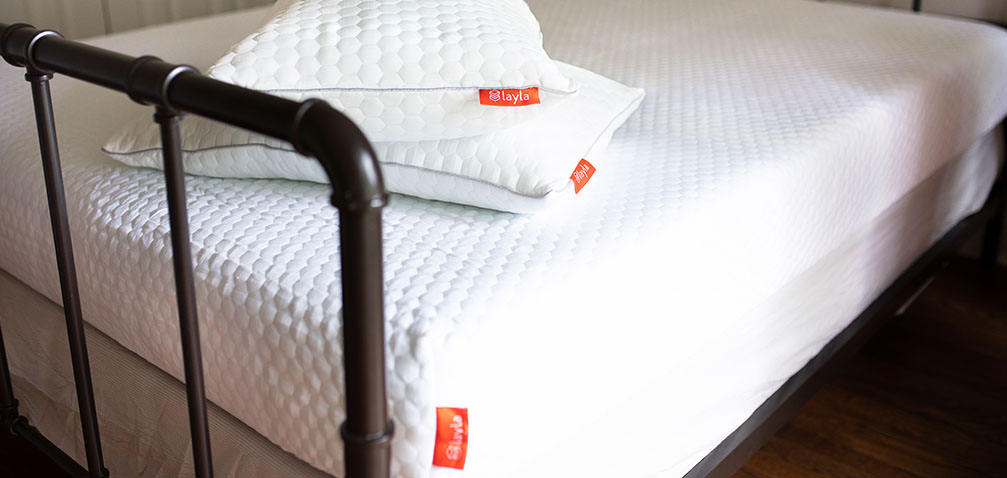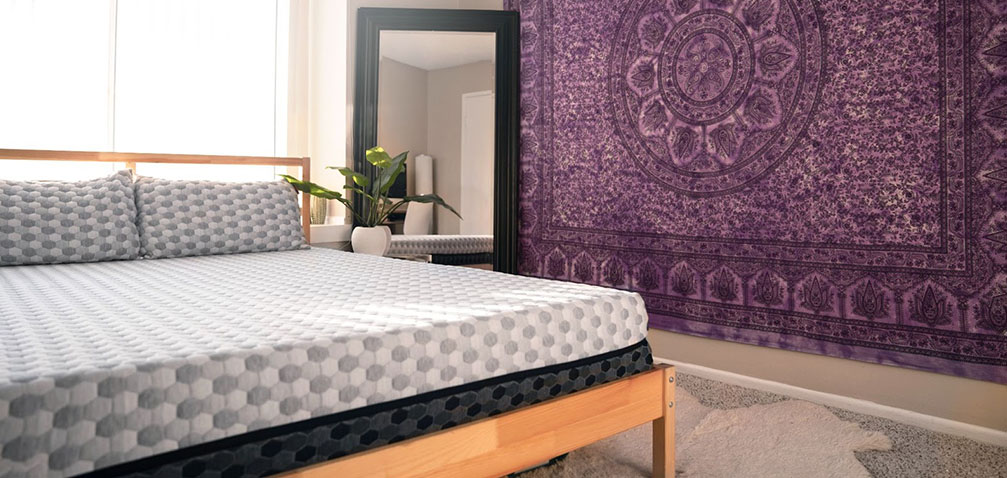- What Is a Box Spring?
- What Is a Mattress Foundation?
- What Is the Difference Between a Box Spring and Foundation?
- What Are Other Types of Bed Bases?
- Do You Need a Box Spring or Foundation for Your Mattress?
- Get Support with Layla Sleep
What Is a Box Spring?
A box spring is a mattress base typically used to support innerspring mattresses. Box springs consist of wood or metal bases with coiled springs inside. The coils offer additional support and bounce when you sleep on the mattress, but they’re not beneficial for all mattress types. Box springs are less common now than they used to be because memory foam is becoming a more popular choice for mattresses.
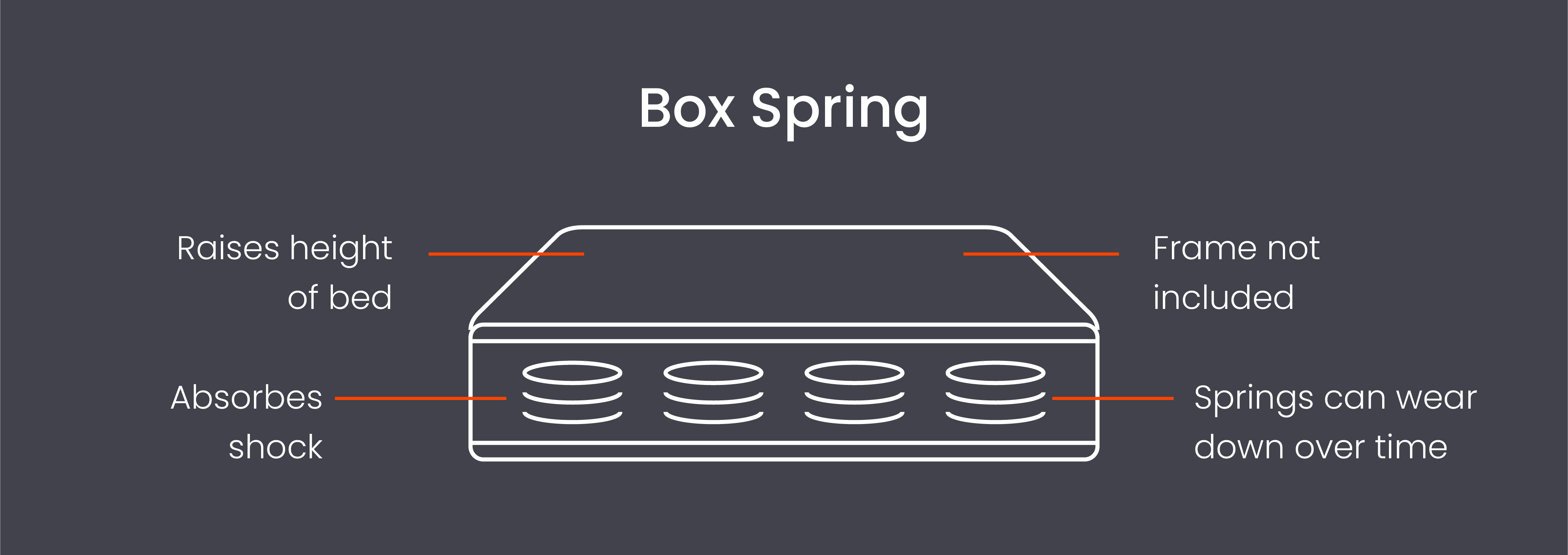
Pros and Cons of Box Springs
Box springs have many pros and cons, but one thing to keep in mind is that they’re not compatible with memory foam mattresses. Therefore, if you have a memory foam mattress or are considering getting one, you will not need a box spring. Meanwhile, a box spring can support the mattress and offer additional comfort if you have an innerspring mattress.
Pros
- Increase airflow: Since box springs contain coils, they can enhance airflow. Essentially, air travels through the coils rather than getting trapped, allowing better mattress breathability to keep you cooler at night.
- Add support to your mattress: Box springs support the mattress and extend its life by evenly distributing your body weight to prevent sagging.
- Absorb motion: The coils in box springs absorb shock and motion. Therefore, if you share your bed with a partner, a box spring can prevent their tossing and turning from causing too much motion on your side.
- Affordable: Box springs are affordable because they don’t require a bed frame. Instead, you can use a box spring on the floor of your bedroom, which may be ideal if you share your bed with pets because they won’t need to jump to cuddle up with you.
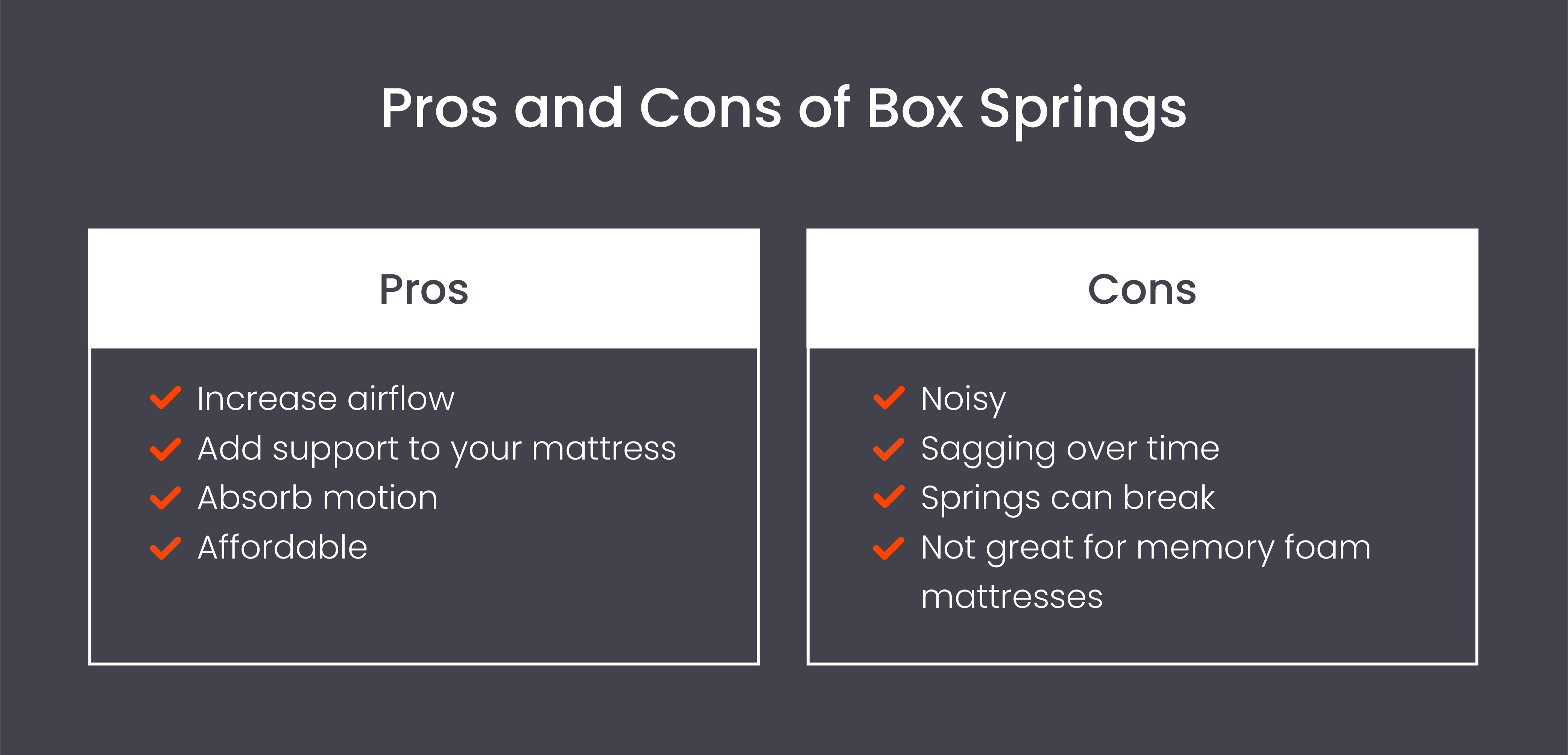
Cons
- Noisy: Since box springs are made with coils, they can be noisy when you move around on them. Coils will typically become squeaky as they’re worn down over time.
- Sagging over time: Box springs sag over time, especially if you sleep in the same area of your mattress. Continued stress on the coils from your body weight can cause the mattress to sag in some areas and may break down over time and become uneven.
- Not great for memory foam mattresses: You should never use your box spring with a memory foam mattress. Foam mattresses are constructed differently from innerspring mattresses and require flat and stable foundations. Since box springs have springs, they can cause the mattress to give, leading to sagginess or poor sleep quality. Of course, some mattresses may be designed for use with box springs, so always check the warranty to determine if you need a box spring or another type of bed base.
- Springs can break: Unfortunately, box springs don’t last forever. You can break the springs if you jump on your bed or use the same box spring for many years. When springs are broken, they can poke through to the mattress, causing lumps and sagging throughout and making it less comfortable.
What Is a Mattress Foundation?
Mattress foundations are similar to box springs in that they’re designed to support the mattress and keep it off the floor. So what is a bed foundation, and how is it different? Mattress foundations are wooden boxes with flat slats that are usually covered by a thin layer of fabric. However, you can also find mattress foundations that are solid wooden structures without any slats. The space between the slats will determine how much support there is for the mattress. For example, the more space between slats, the less supportive the foundation is. Therefore, mattress foundations made from solid structures offer optimal support but potentially less breathability because they don’t promote airflow.

Of course, they don’t have any springs in them, which better supports the mattress to keep it from sagging. Some mattress foundations are designed to sit on the floor, while others are used with a bed frame.
Pros and Cons of Foundations
Both box springs and foundations are designed to provide support for your mattress. When paired with a frame, they can help you lift your bed off the floor. Here are a few of the pros and cons of foundations for mattresses:
Pros:
- Compatible with all mattress types: Foundations are ideal for all mattress types, including memory foam, latex, innerspring, and hybrid mattresses.
- Durable: Box springs can break down over time because coils aren’t built to last. However, since foundations are constructed from wood, they’re more durable and less likely to break down over time.
- Adequate support: Foundations are designed to offer support for your mattress. Compared to box springs, foundations offer firmer support, making your mattress feel more supported.
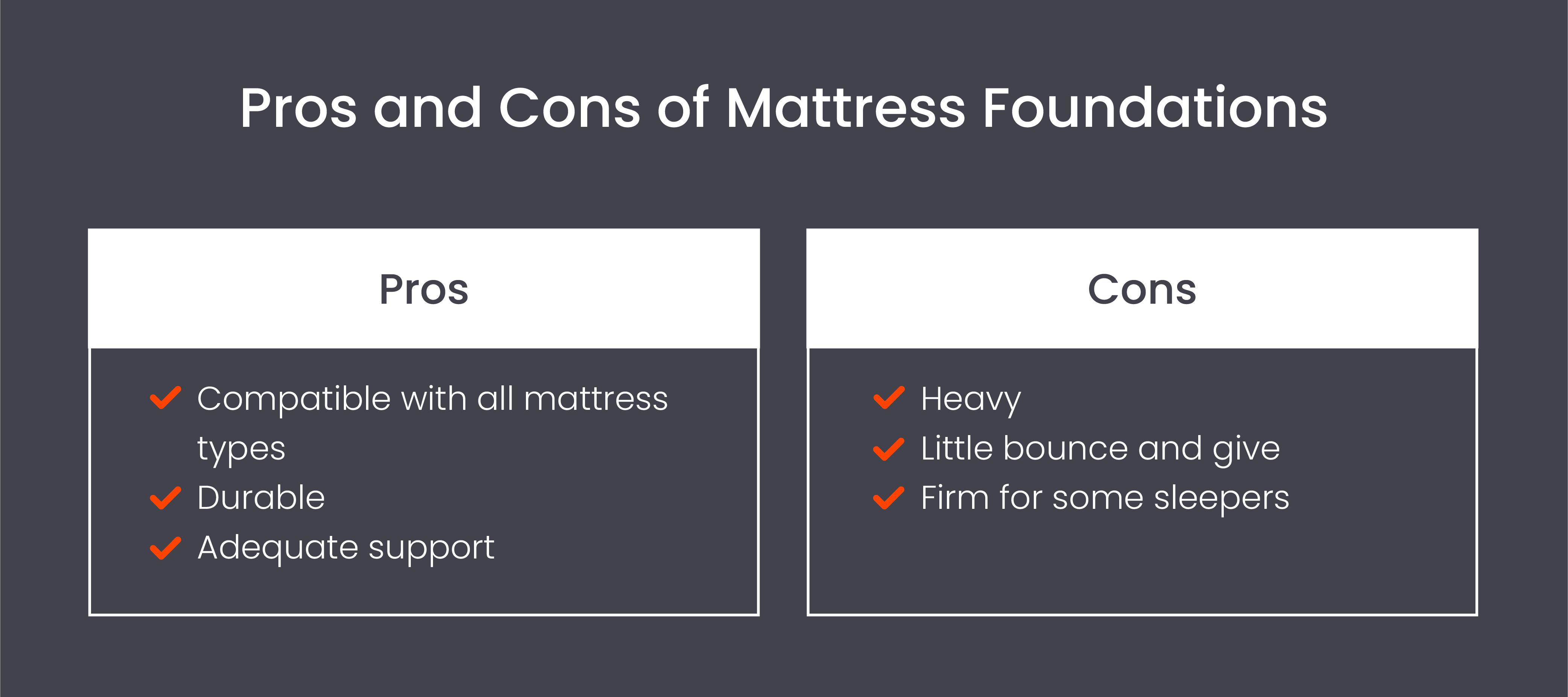
Cons:
- Heavy: Foundations are much heavier than box springs and take up more space when used with a bed frame. If you’re moving, they’ll be more difficult to transport, and you won’t be able to break them down since they’re already constructed.
- Little bounce and give: There’s no bounce with a foundation because there are no springs. Therefore, there’s very little give, which could cause aches and pains for some individuals, depending on their sleep positions.
- Firm for some sleepers: Because there’s no bounce or give, foundations make the mattress firmer, which may make it too firm for some sleepers.
What Is the Difference Between a Box Spring and Foundation?
Now that you understand the pros and cons of box springs and foundations, you might be wondering what the difference is between them to help you make the right choice for your new mattress. Here’s what to look for in a mattress foundation vs. box spring:

Durability
Foundations are considered more durable than box springs because they don’t wear down over time. Coils in box springs can break or wear, causing lumps and bumps in the mattress and loud squeaky sounds. Ultimately, the more you use your box spring, the faster it will wear down, but this isn’t the case for foundations, which can last years with proper use.
Mattress compatibility
Box springs are ideal for innerspring mattresses because they were designed to support them while absorbing motion. However, they’re not ideal for memory foam, latex, or hybrid mattresses because they can make them uneven and saggy. If you’re unsure whether to choose a box spring vs. foundation, you can check your mattress warranty for more information. Using the wrong support can void the warranty for some mattresses, especially if you use a box spring with a memory foam mattress. You can also contact the manufacturer if you lose your warranty to ensure you’re using the right products with your mattress to extend its life.
Support
Box springs and foundations are designed to support the mattress and the sleeper. Since box springs are constructed with springs, they’re bouncy but firm. Meanwhile, foundations offer more solid support. With slats or solid construction, they can offer the ultimate support, making mattresses feel firmer.
Construction
Box springs and foundations look similar. For example, the springs in box springs and the slats in foundations are covered by thin fabric, and they’re both in the shape of a box. However, they’re not constructed the same. Box springs are bases made from wood or metal and contain coils. Meanwhile, foundations are bases made from wood slats or panels. Foundations may also not have a thin fabric on top of the slats, depending on the type of foundation you purchase.
Weight
Box springs are typically lighter than solid foundations, making them difficult to transport. Therefore, if you’re planning to move soon, you might want to hold off on buying a foundation until you’re ready to move into your new home. However, just because they’re heavy doesn’t mean they’re immovable. With the help of a friend, you can easily move your foundation into a moving van or across the room when redesigning your bedroom.
Price
While the cost of a box spring vs. mattress foundation varies depending on the brand and size, foundations are typically more expensive. However, since they last longer and are more durable and sturdy than box springs, foundations may be more cost-effective because they can save you money in the long run since you won’t have to replace them as frequently, if at all.
What Are Other Types of Bed Bases?
Box springs and foundations aren’t your only bed base options. Choosing the right base for your bed depends on a number of factors, including your preferences for support, comfort, and firmness, and how high you want your bed to be off the floor. Other types of bed bases include:
- Adjustable bed: Adjustable bed bases allow you to elevate your head or feet while you sleep or rest in bed. They are ideal for those who like to spend time reading or watching television in bed. They are also comfortable for those with disabilities and the elderly because they can help keep the feet and head in the proper position to support the body. Of course, when using an adjustable bed base, you need an adjustable mattress, so always confirm your mattress is compatible.
- Platform bed: A platform bed is similar to a mattress foundation in that they both have wooden slats to fully support any type of mattress. Platform bed bases are single pieces of furniture that are raised off the floor. While foundations typically require a frame if you want space under the bed, platforms don’t require additional box springs or foundations.
- Bunkie board: Bunkie boards are ideal for mattresses that require extra support; they’re thin pieces of wood that go under the mattress and on top of another bed base. They work with any type of mattress but can be especially beneficial for bed frames with slats that don’t offer enough support. Bunkie boards can also be used to make a soft mattress firmer.
Do You Need a Box Spring or Foundation for Your Mattress?
After learning about the differences between a box spring and foundation, you might wonder, “Do you need a box spring, foundation, or bed base?” Unless you plan to sleep with your mattress on the floor, you should always have a box spring or foundation, unless you have a platform bed. Since platform beds combine the frame and the foundation, you don’t need any other products to support your mattress.
In most cases, you should have something between the mattress and the floor to absorb shock and reduce regular wear and tear. Keeping your mattress off the floor improves airflow to prevent it from collecting mold and dust or getting too hot while you sleep, ensuring the mattress can properly contour your body.
Get Support with Layla Sleep
Giving your mattress the right support can make it more comfortable while prolonging its lifespan. Whether you need a box spring or foundation depends on the type of mattress you have and the specific instructions on your warranty. While both options provide ultimate support and comfort, foundations are best for memory foam, latex, and hybrid mattresses.
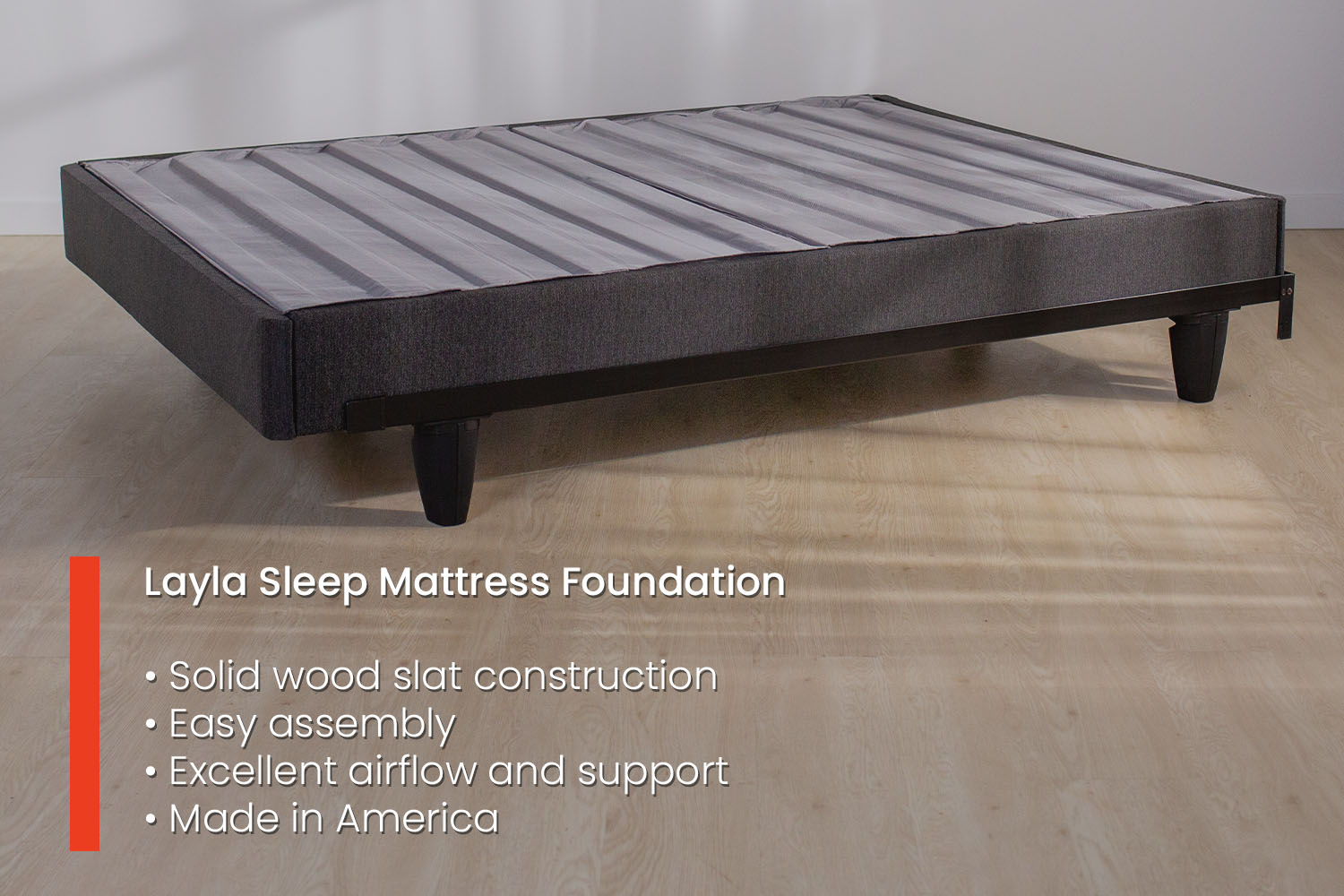
Looking for a bed base for your favorite mattress? Check out Layla Mattress Foundations and bed bases. We offer platform beds, adjustable bases, foundations and bedframes, and metal platform bases to help you sleep comfortably every night. Pair your bed frame with a foundation or box spring, or use a platform bed as a single piece. Our bed bases and mattress frames are easily assembled and made to last.

